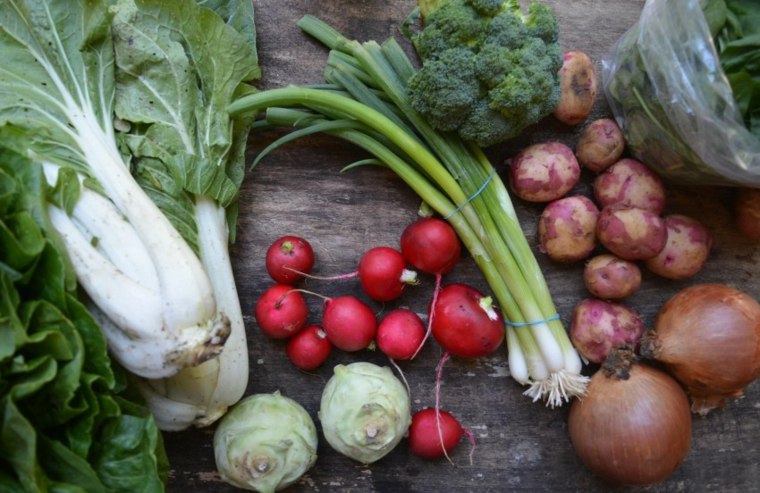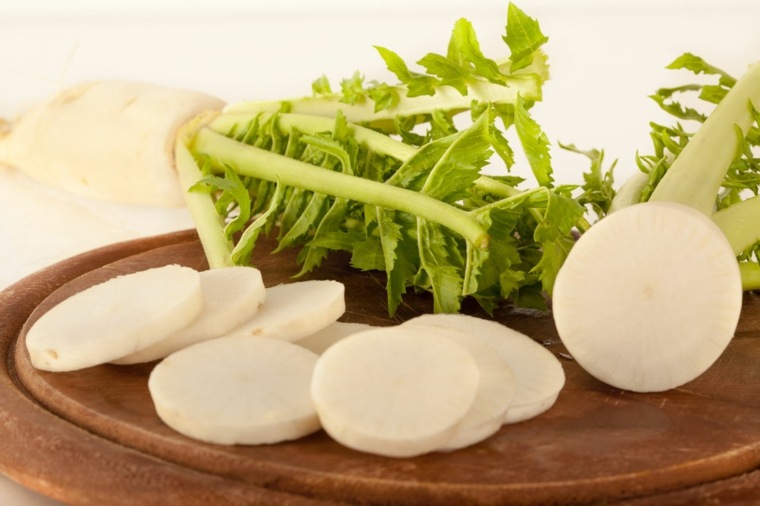Frutas y verduras. La relación que guardan sus colores con los beneficios para la salud que tienen
Frutas y verduras: La relación entre sus colores y los beneficios para la salud
Las frutas y verduras son elementos fundamentales en una dieta equilibrada y saludable. No solo aportan nutrientes esenciales para el buen funcionamiento de nuestro organismo, sino que también pueden prevenir diversas enfermedades gracias a los beneficios que ofrecen. Es interesante observar cómo sus colores están asociados a diferentes propiedades y cómo estos afectan positivamente nuestra salud.
El color de las frutas y verduras se debe a la presencia de pigmentos naturales, como los carotenoides, flavonoides, antocianinas y clorofila. Estos pigmentos no solo brindan una apariencia atractiva a los alimentos, sino que también desempeñan un papel crucial en la protección y el mantenimiento de la salud de nuestro organismo.
Las frutas y verduras de color rojo, como los tomates, fresas y sandías, contienen licopeno, un tipo de carotenoide que se ha asociado con la reducción del riesgo de enfermedades cardiovasculares y ciertos tipos de cáncer. Además, los alimentos rojos también son ricos en vitamina C, que fortalece el sistema inmunológico y actúa como antioxidante, protegiendo nuestras células del daño causado por los radicales libres.
Las frutas y verduras de color naranja, como zanahorias, calabazas y naranjas, son ricas en betacarotenos, los cuales son convertidos por nuestro organismo en vitamina A. La vitamina A es esencial para la salud ocular, el crecimiento y desarrollo de los huesos, así como para el mantenimiento de la piel y las mucosas. Además, los alimentos naranjas también contienen vitamina C y antioxidantes que ayudan a mejorar nuestra visión y a fortalecer el sistema inmunológico.
Las frutas y verduras de color amarillo, como el plátano, el limón y la piña, son una excelente fuente de vitamina C y otros antioxidantes que favorecen la salud de nuestra piel, nuestro sistema inmunológico y pueden proteger contra enfermedades respiratorias y cardiovasculares.
Las frutas y verduras de color verde, como espinacas, brócoli y kiwi, son conocidas por ser ricas en clorofila y carotenoides, como la luteína y la zeaxantina. Estos nutrientes son esenciales para la salud ocular, ya que ayudan a prevenir enfermedades como las cataratas y la degeneración macular. Además, los alimentos verdes también son una fuente de vitamina K, ácido fólico y fibra, lo que contribuye a la salud cardiovascular y digestiva.
Las frutas y verduras de color morado, como las uvas, las berenjenas y las moras, contienen antocianinas, unos pigmentos con poderosas propiedades antioxidantes. Estos compuestos han demostrado tener efectos positivos en la prevención de enfermedades del corazón, la mejora de la memoria y la salud cerebral.
En conclusión, consumir una variedad de frutas y verduras de diferentes colores es fundamental para obtener los beneficios que cada una de ellas nos ofrece. Cada color está asociado con diferentes nutrientes y propiedades que fortalecen nuestro organismo y nos protegen contra enfermedades. Aprovechemos la amplia gama de colores que nos brindan las frutas y verduras para disfrutar de una vida más saludable. ¡Incorporemos estos alimentos en nuestra dieta diaria y mantengámonos siempre saludables! Además de los nutrientes esenciales que aportan, las frutas y verduras también contienen pigmentos naturales que les dan su color característico. Estos pigmentos no solo brindan una apariencia atractiva, sino que también desempeñan un papel importante en la protección y el mantenimiento de nuestra salud.
Las frutas y verduras de color rojo, como los tomates, fresas y sandías, contienen licopeno, que se ha asociado con la reducción del riesgo de enfermedades cardiovasculares y ciertos tipos de cáncer. También son ricas en vitamina C, que fortalece el sistema inmunológico y actúa como antioxidante.
Las frutas y verduras de color naranja, como zanahorias, calabazas y naranjas, son ricas en betacarotenos, que nuestro organismo convierte en vitamina A. Esta vitamina es esencial para la salud ocular, el crecimiento y desarrollo de los huesos, y el mantenimiento de la piel y las mucosas.
Las frutas y verduras de color amarillo, como el plátano, el limón y la piña, son una excelente fuente de vitamina C y otros antioxidantes que favorecen la salud de la piel, el sistema inmunológico y protegen contra enfermedades respiratorias y cardiovasculares.
Las frutas y verduras de color verde, como espinacas, brócoli y kiwi, son conocidas por ser ricas en clorofila y carotenoides, que son esenciales para la salud ocular y contribuyen a la salud cardiovascular y digestiva gracias a su contenido de vitamina K, ácido fólico y fibra.
Las frutas y verduras de color morado, como uvas, berenjenas y moras, contienen antocianinas, que son antioxidantes y tienen efectos positivos en la prevención de enfermedades del corazón, la mejora de la memoria y la salud cerebral.
En resumen, cada color de fruta y verdura está asociado con diferentes nutrientes y propiedades que fortalecen nuestro organismo y nos protegen contra enfermedades. Por lo tanto, es importante consumir una variedad de frutas y verduras de diferentes colores para obtener todos los beneficios que ofrecen. ¡Incorporemos estos alimentos en nuestra dieta diaria y disfrutemos de una vida más saludable! En general, consumir una variedad de frutas y verduras de diferentes colores es fundamental para obtener los diferentes beneficios que cada una de ellas nos ofrece. Cada color está asociado con diferentes nutrientes y propiedades que fortalecen nuestro organismo y nos protegen contra enfermedades.
Por ejemplo, las frutas y verduras rojas como los tomates, fresas y sandías contienen licopeno, un antioxidante que se ha asociado con la reducción del riesgo de enfermedades cardiovasculares y ciertos tipos de cáncer. Además, son ricas en vitamina C, que fortalece el sistema inmunológico y actúa como antioxidante.
Las frutas y verduras de color naranja, como las zanahorias, calabazas y naranjas, son ricas en betacarotenos, que nuestro organismo convierte en vitamina A. Esta vitamina es esencial para la salud ocular, el crecimiento y desarrollo de los huesos, y el mantenimiento de la piel y las mucosas.
Las frutas y verduras de color amarillo, como el plátano, el limón y la piña, son una excelente fuente de vitamina C y otros antioxidantes que favorecen la salud de la piel, el sistema inmunológico y protegen contra enfermedades respiratorias y cardiovasculares.
Las frutas y verduras de color verde, como las espinacas, brócoli y kiwi, son conocidas por ser ricas en clorofila y carotenoides, que son esenciales para la salud ocular y contribuyen a la salud cardiovascular y digestiva debido a su contenido de vitamina K, ácido fólico y fibra.
Las frutas y verduras de color morado, como las uvas, berenjenas y moras, contienen antocianinas, que son antioxidantes y tienen efectos positivos en la prevención de enfermedades del corazón, la mejora de la memoria y la salud cerebral.
En conclusión, aprovechemos la amplia gama de colores que nos brindan las frutas y verduras para disfrutar de una vida más saludable. ¡Incorporemos estos alimentos en nuestra dieta diaria y mantengámonos siempre saludables! El consumo de una variedad de frutas y verduras de diferentes colores es fundamental para obtener los beneficios que cada una de ellas nos ofrece. Cada color está asociado con diferentes nutrientes y propiedades que fortalecen nuestro organismo y nos protegen contra enfermedades. Aprovechemos la amplia gama de colores que nos brindan las frutas y verduras para disfrutar de una vida más saludable. ¡Incorporemos estos alimentos en nuestra dieta diaria y mantengámonos siempre saludables! En resumen, los colores de las frutas y verduras están asociados a diferentes beneficios para la salud:
– Frutas y verduras rojas: Contienen licopeno, un antioxidante que reduce el riesgo de enfermedades cardiovasculares y ciertos tipos de cáncer. También son ricas en vitamina C, que fortalece el sistema inmunológico y actúa como antioxidante.
– Frutas y verduras naranjas: Son ricas en betacarotenos, que se convierten en vitamina A en nuestro organismo. La vitamina A es esencial para la salud ocular, el crecimiento y desarrollo de los huesos, y el mantenimiento de la piel y las mucosas.
– Frutas y verduras amarillas: Son una excelente fuente de vitamina C y otros antioxidantes que favorecen la salud de la piel, el sistema inmunológico y protegen contra enfermedades respiratorias y cardiovasculares.
– Frutas y verduras verdes: Son ricas en clorofila y carotenoides, esenciales para la salud ocular y contribuyen a la salud cardiovascular y digestiva debido a su contenido de vitamina K, ácido fólico y fibra.
– Frutas y verduras moradas: Contienen antocianinas, antioxidantes que previenen enfermedades del corazón, mejoran la memoria y promueven la salud cerebral.
Es importante consumir una variedad de frutas y verduras de diferentes colores para obtener todos estos beneficios y mantener una buena salud. Incorporar estos alimentos en nuestra dieta diaria nos ayuda a fortalecer nuestro organismo y protegernos contra enfermedades. Además, las frutas y verduras también contienen otros nutrientes esenciales como vitaminas, minerales y fibra que contribuyen a nuestro bienestar general. Por lo tanto, es importante incluir una variedad de colores en nuestra alimentación para asegurarnos de obtener todos los nutrientes necesarios para mantenernos saludables.
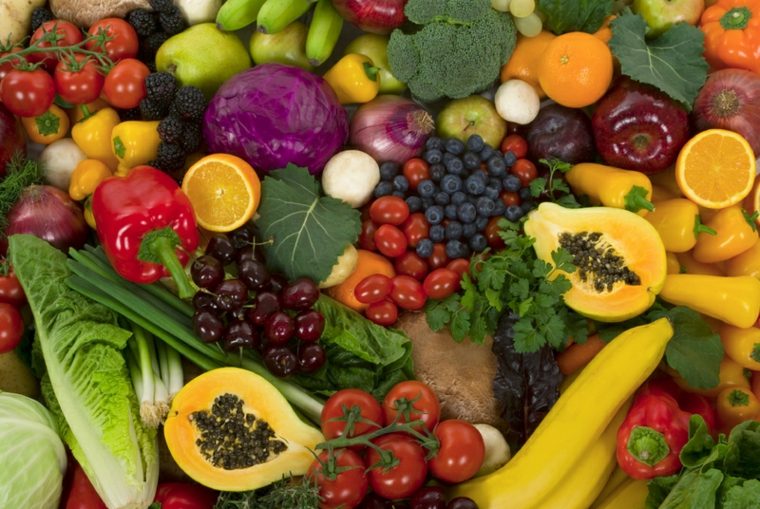 Las frutas y verduras vienen en diferentes colores y cada uno de estos colores es el resultado de su contenido de ciertos antioxidantes, fitonutrientes y nutrientes. But how do we know which fruits and vegetables we should eat and in what quantities to stay healthy? The answer is simple: we should consume fruits and vegetables of all the colors of the rainbow every day to get all the health benefits that nature offers us.
Las frutas y verduras vienen en diferentes colores y cada uno de estos colores es el resultado de su contenido de ciertos antioxidantes, fitonutrientes y nutrientes. But how do we know which fruits and vegetables we should eat and in what quantities to stay healthy? The answer is simple: we should consume fruits and vegetables of all the colors of the rainbow every day to get all the health benefits that nature offers us.
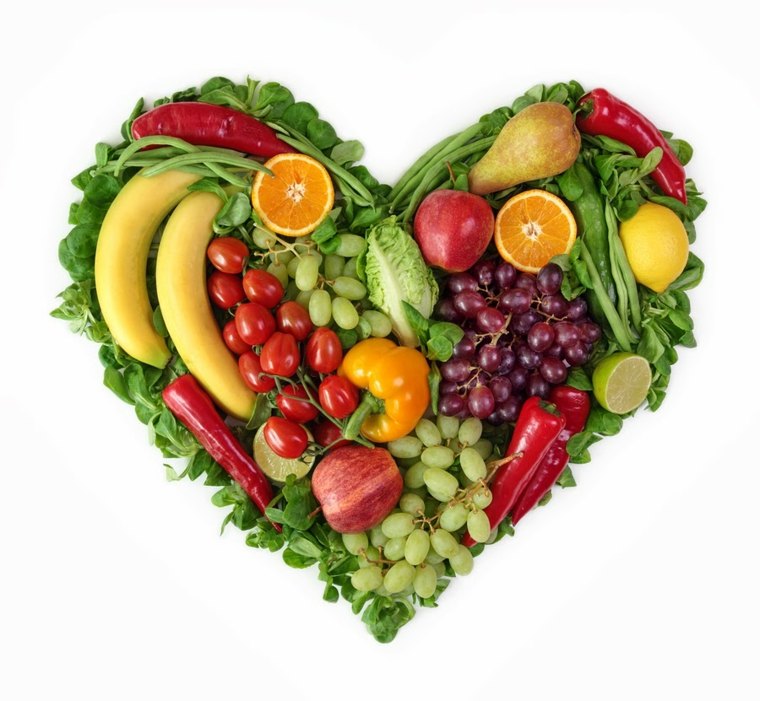
The different colors of fruits are the result of different pigments, and each of them offers different health benefits. In general, the darker the color, the greater the health benefit of the product. Following this principle, dark green romaine lettuce will have more nutritional value than light green iceberg lettuce, sweet potatoes have more health benefits than white potatoes, and so on.
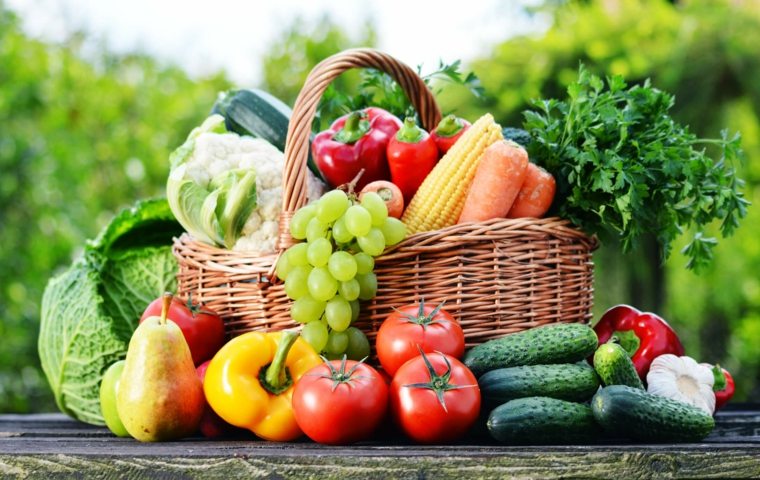
We’re Eating Too Much Beige!
Unfortunately, the standard diet of many people lacks colorful fruits and vegetables, and beige is the predominant color. Cookies, breads, etc. have become the staple of contemporary eating habits.

These foods are cheap, readily available, and tasty, but they are also filled with harmful ingredients. It’s no wonder that more and more people are struggling with high cholesterol, hypertension, diabetes, etc. Therefore, it is very important to eat more multicolored fruits and vegetables to get all the health benefits they offer.
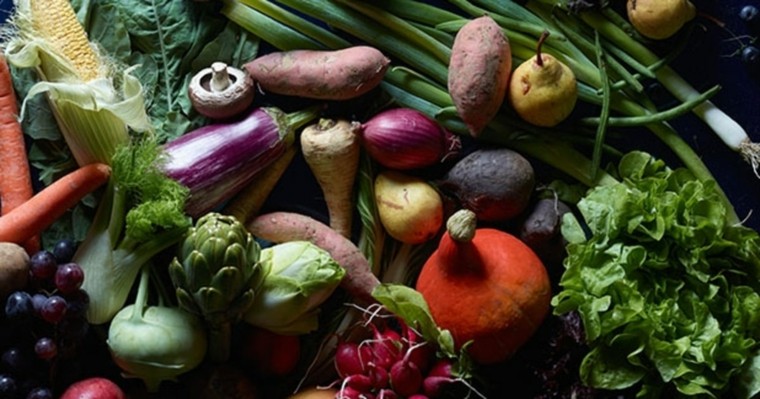
Color and Diet: What Does Color Have to Do with Diet?
Have you ever wondered why spinach is so green and blueberries are blue? The answer is one word – phytochemicals. These substances are only found in nature in plants and provide us with numerous health benefits.
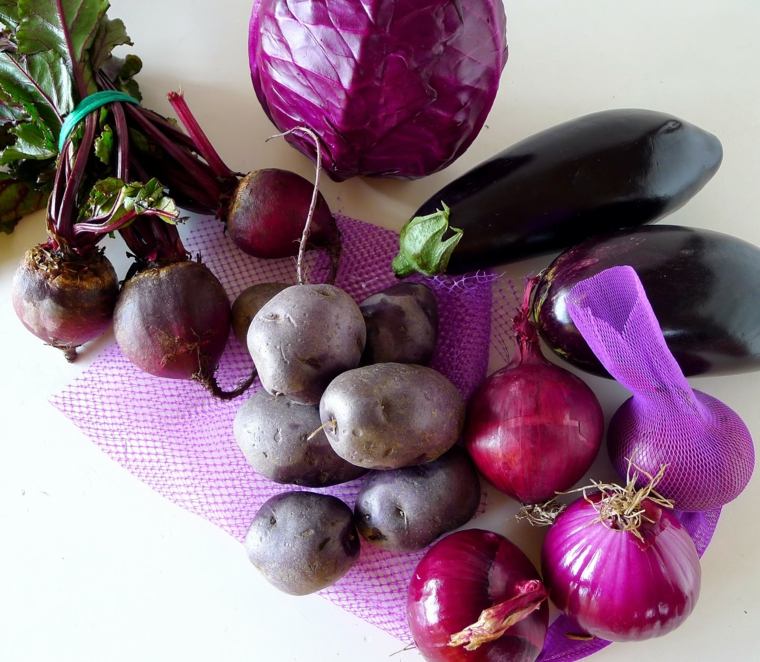
Scientists also believe that phytochemicals give fruits and vegetables their color, while also interacting with vitamins, minerals, and other substances to provide the human body with various benefits. This is the main reason why colorful fruits and vegetables can provide heart benefits and reduce the risk of various lifestyle-related diseases.
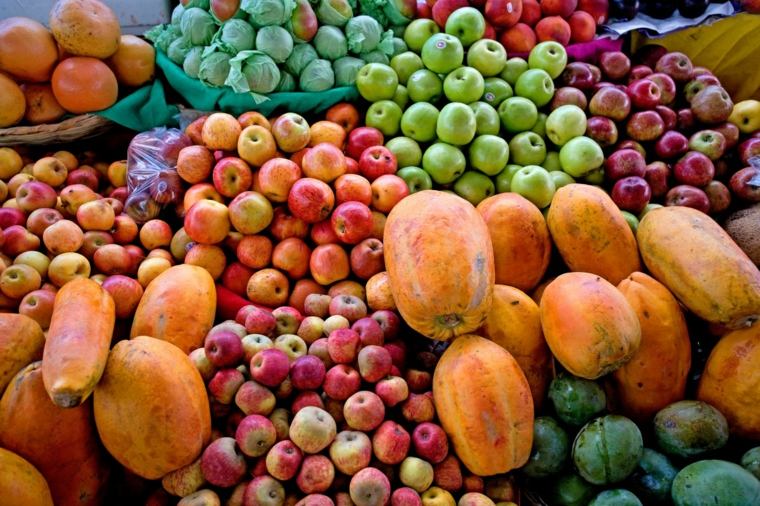
Does this mean that a fruit of a single color only contains a single type of phytochemical? The answer is no, even a fruit of a single color still contains multiple phytochemicals along with vitamins and minerals to provide us with various benefits that make us healthier.

When you eat fruits and vegetables of different colors every day, you ensure an intake of a variety of nutrients that work synergistically with phytochemicals. Therefore, a pragmatic way to achieve optimal and healthy nutrition is to eat a variety of foods in the colors of the rainbow.
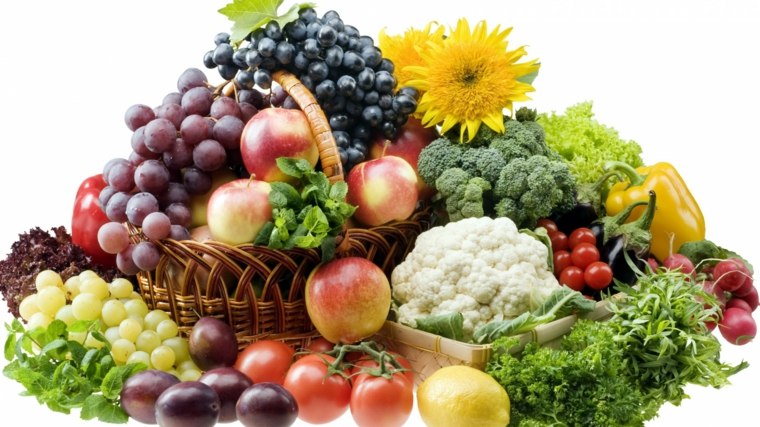
Now let’s see what are the most common colors in nature and the food groups they represent:
What Do the Different Colors of Fruits and Vegetables Mean?
Blue and Purple
Discover the Power of Colorful Fruits and Vegetables
Did you know that the color of fruits and vegetables can tell you a lot about their nutritional value? From vibrant blues and purples to rich greens and bright reds, each color represents a unique set of health benefits. Let’s explore the power of colorful produce!
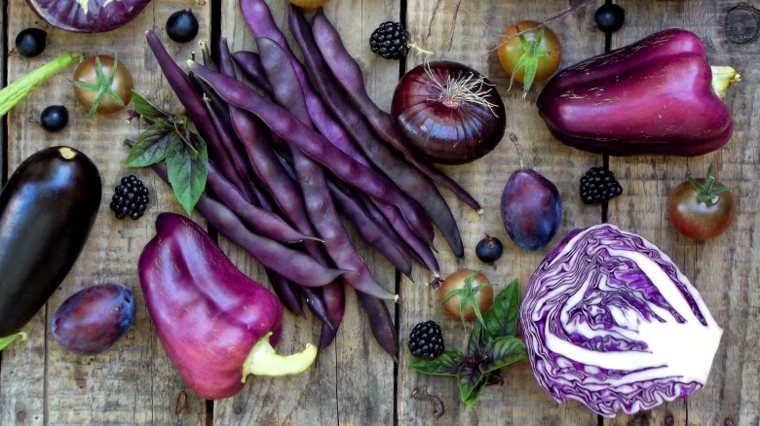
Blue or Purple: These colors are due to the presence of anthocyanins in the fruit. Anthocyanins are antioxidants that provide numerous heart-healthy benefits. The darker the blue, the higher the concentration of phytochemicals. So, indulge in blueberries, eggplants, and other blue vegetables to strengthen your heart. Blueberries, in particular, are known for their high levels of antioxidants. Other fruits rich in anthocyanins include pomegranates, blackberries, plums, and raisins.
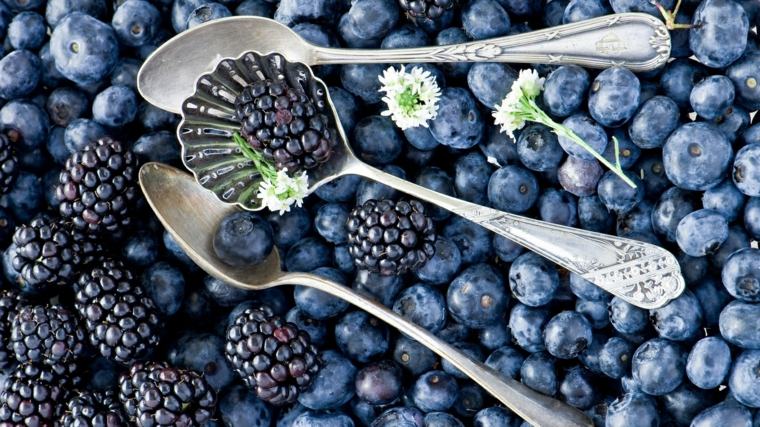
Blue and purple foods not only add color to your plate but also offer significant nutritional value. The blue color in blueberries, for example, comes from a powerful antioxidant called anthocyanin, which protects against cancer and cardiovascular diseases.
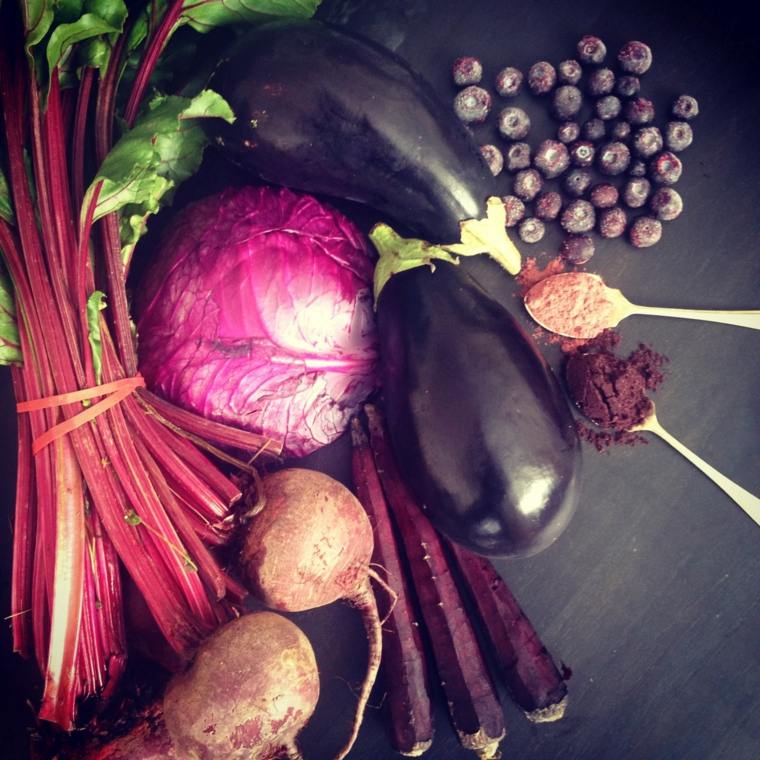
A study published in the Romanian journal “Nutritional and Metabolic Diabetes” in 2017 linked the consumption of purple foods, such as eggplants, to a reduction in oxidative stress in hyperglycemic rats. Oxidative stress is associated with various diseases, including heart disease, cancer, and Parkinson’s disease.
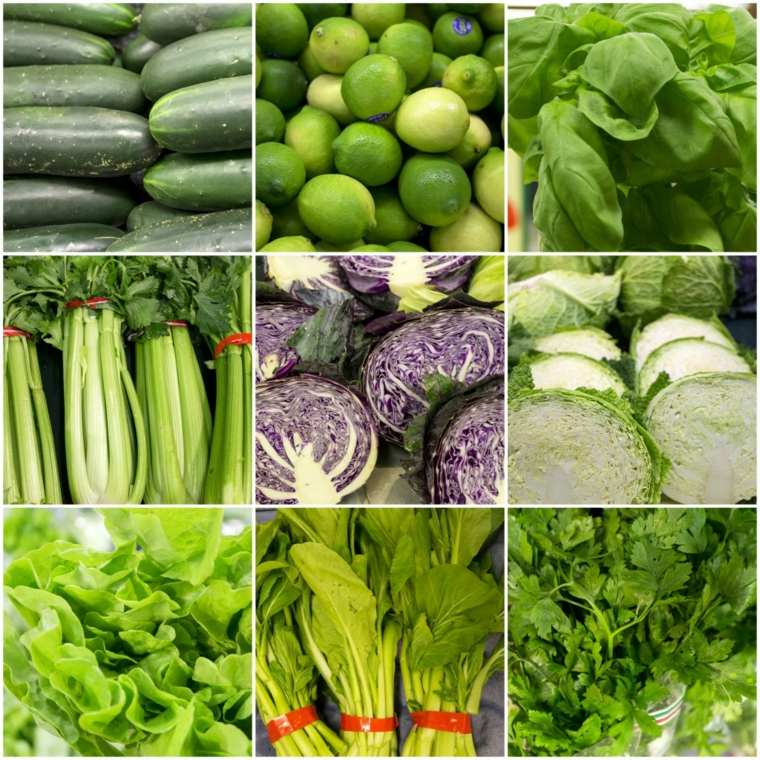
Light and Dark Green:
Leafy green vegetables are rich in chlorophyll and isothiocyanates, which reduce liver carcinogens. They also contain various other anticancer compounds. In addition to these antioxidants, dark green cruciferous vegetables are high in vitamin K, folic acid, potassium, and more. So, make sure to include plenty of lettuce, Brussels sprouts, broccoli, and dark leafy greens in your healthy diet.

Green and Yellow: Fruits and vegetables with these colors are rich in lutein, which is essential for eye health. Lutein is particularly important for older individuals in preventing age-related macular degeneration. Some green-yellow fruits and vegetables are also high in vitamin C. Examples include avocados, kiwis, spinach, and pistachios.

Dark Green Vegetables: If you’re looking to increase your iron intake, dark green vegetables are a safe bet. Spinach, for example, contains 3.2 mg of iron in half a cup. Peas, leafy greens, and beans are also good sources of iron.
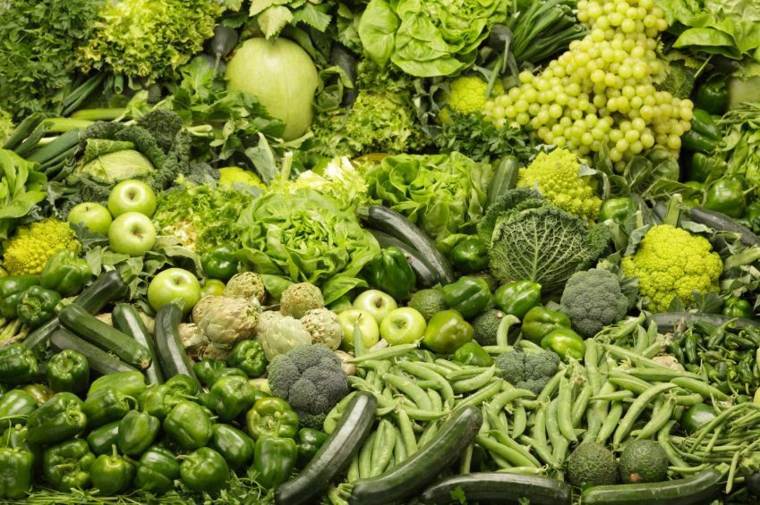
Keep in mind that iron from plant sources is not as easily absorbed as iron from animal sources. You may need to consume more iron-rich vegetables to obtain the same amount as you would from eating meat.
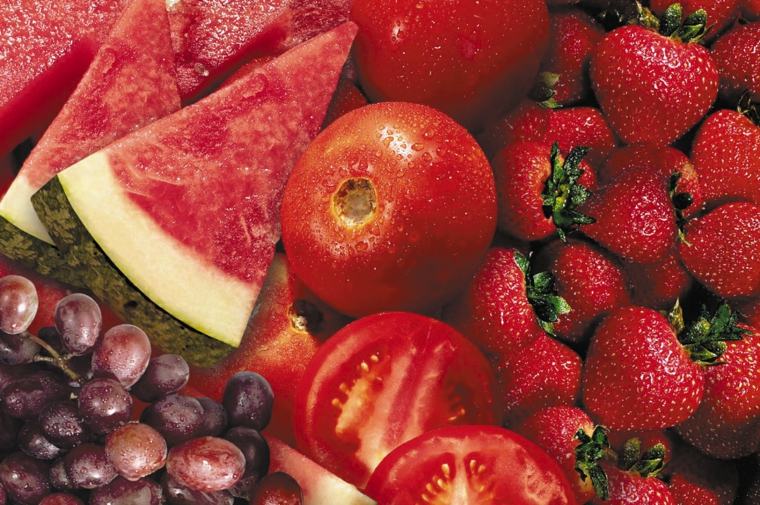
Red Fruits and Vegetables
The main pigment that gives red fruits and vegetables their color is lycopene. It is a powerful antioxidant that is being researched for its potential in preventing cancer and heart attacks. Lycopene is also beneficial for prostate health and maintaining breast tissue.
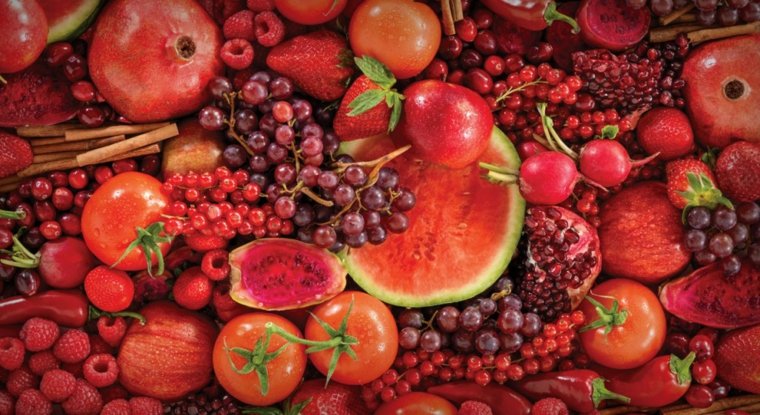
Red fruits and vegetables are also rich in flavonoids, resveratrol, vitamin C, and folate. Resveratrol, found abundantly in the skin of red grapes, is an antioxidant being investigated for its cancer-preventive properties. Examples of red fruits include grapes, blueberries, tomatoes, watermelons, guava, and pomegranates.
By incorporating a variety of colorful fruits and vegetables into your diet, you can enjoy a wide range of health benefits. So, go ahead and make your plate a vibrant rainbow of nutrition!
Eating a Rainbow: The Power of Colorful Fruits and Vegetables
elo rosado, etc.
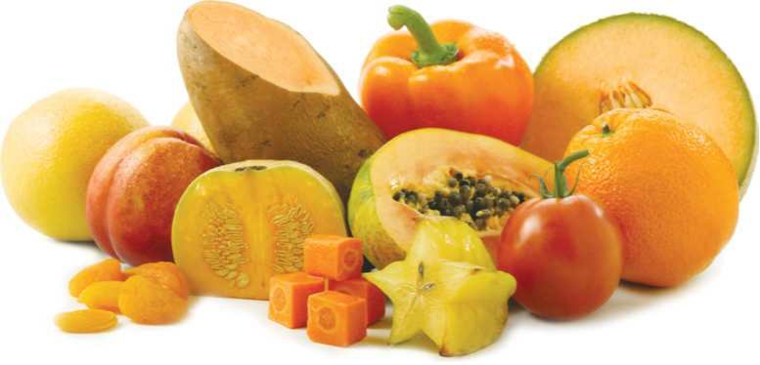
Amarillo / Naranja: Did you know that the vibrant yellow-orange-red color in certain fruits and vegetables is due to carotenoids or beta-carotene? These compounds are not only responsible for the beautiful hues but also packed with vitamin A and retinol, which are essential for preventing acne and wrinkles. Vitamin A is also crucial for maintaining a strong immune function and healthy vision. Research shows that certain beta-carotenoids can even help prevent stomach and esophageal cancers. Some examples of fruits in these colors include mangoes, apricots, peaches, carrots, and pumpkins.
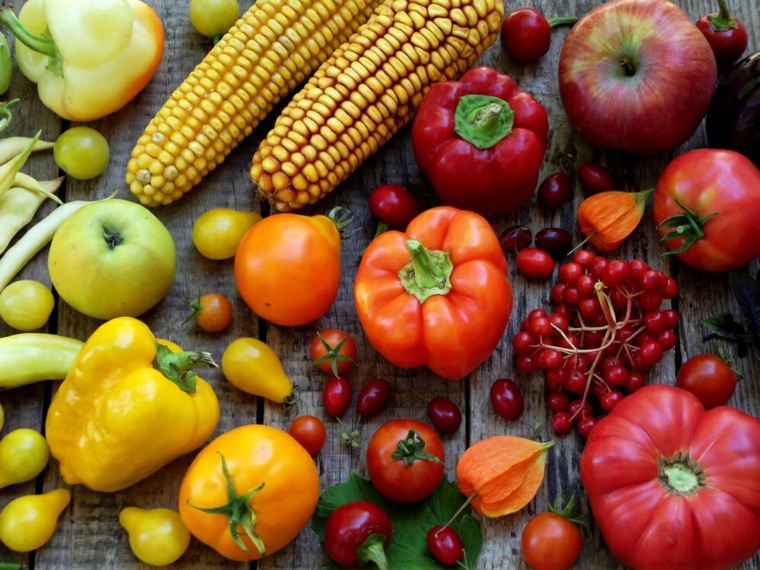
When it comes to fruits and vegetables, the red and orange ones are among the richest sources of vitamin C. Did you know that half a cup of red bell peppers contains 95 milligrams of vitamin C, which is approximately 25 mg more than what you would find in an orange – often considered the gold standard for vitamin C? Even a cup of strawberries provides 85 mg. However, not all red fruits are high in vitamins. A medium-sized tomato, for example, contains only 16 mg of vitamin C, much less than half a bunch of broccoli, which has 51 mg.

White or Colorless Fruits and Vegetables
White vegetables may not seem as colorful as others, but they can be incredibly nutritious. Cauliflower and turnips, for example, contain rich compounds known as glucosinolates, which provide protection against cancer.
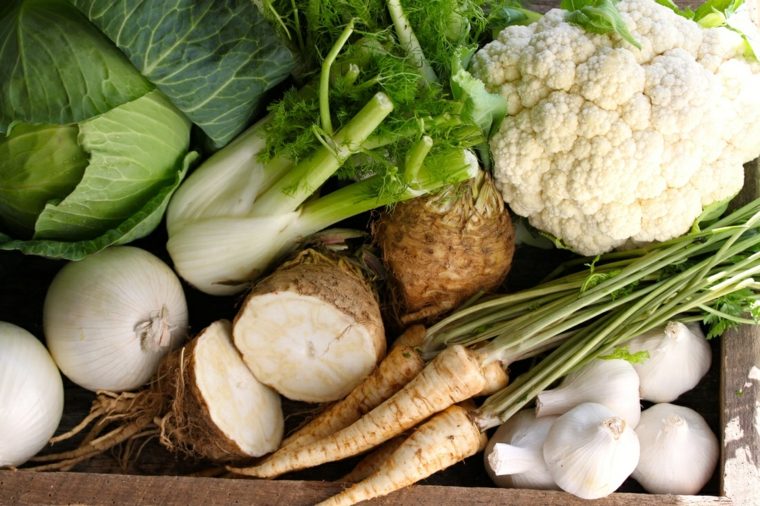
Garlic and onions, on the other hand, contain antioxidants called polyphenols, which play a crucial role in treating chronic inflammation. White beans are a valuable source of protein and fiber, as well as vitamins B and potassium.
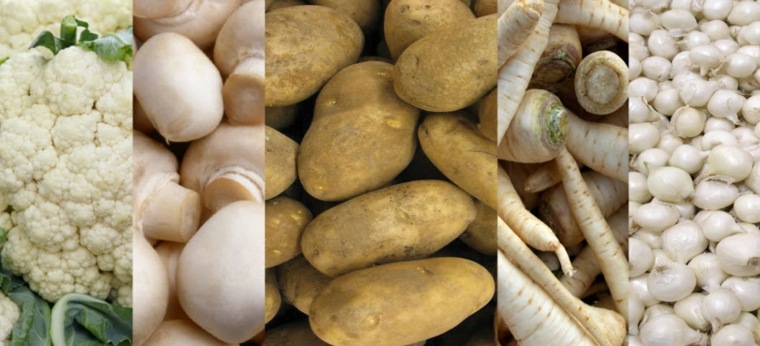
Some vegetables may not have color on the inside, like eggplants. But don’t be fooled – they are not deficient in nutrients or phytochemicals. In fact, many types of colorless flavonoids still help the body fight against the formation of free radicals.
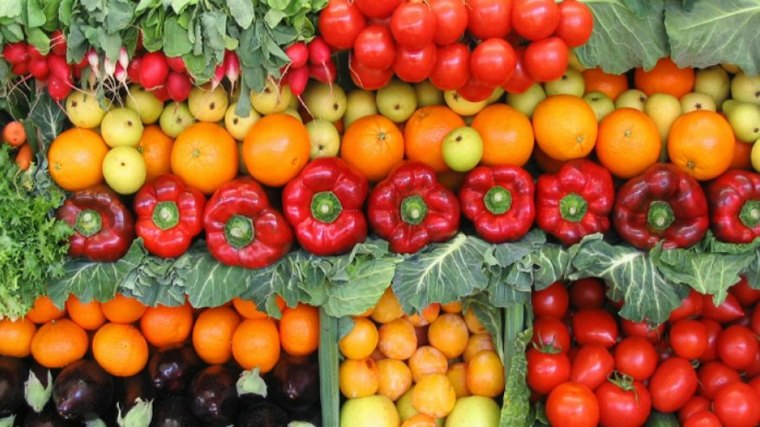
Eat and Count Colors
Experts recommend including fruits and vegetables of all colors of the rainbow in our diet to reap their health benefits. So, next time you go grocery shopping, take a look at your cart. If you notice that you’ve only picked green items from the produce section, such as spinach, green apples, and kiwis, go back and swap one of them for oranges, strawberries, or blueberries. There are nearly 4,000 phytochemicals available in nature, and to enjoy their wonderful benefits, we need to eat fruits and vegetables that are as multicolored as possible every day.
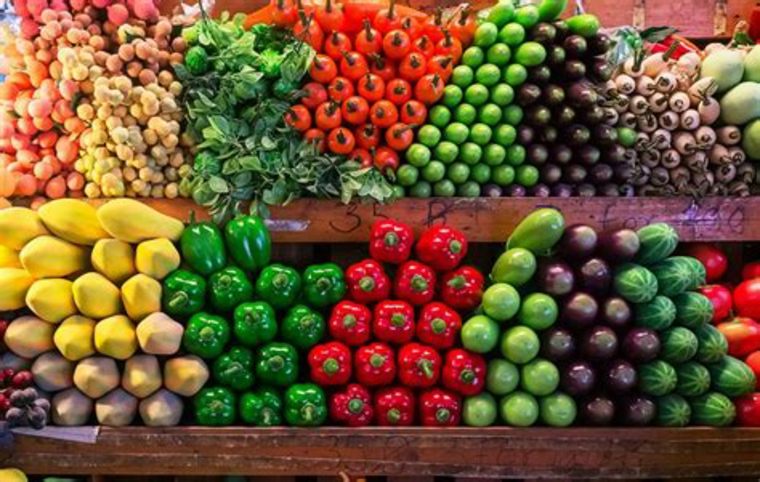
The wide range of bright colors that give fruits and vegetables their visual appeal comes from three basic types of pigments: carotenoids, which give orange and yellow vegetables their colors; flavonoids, which provide blue, red, and cream hues; and chlorophyll, which gives vegetables their green color.

These colorful compounds also offer health benefits and contribute to a healthy diet. Consuming them while understanding the nutritional value of vegetable colors is the best thing you can do for your overall well-being.

Eat the Rainbow:
Using the beautiful colors that make up a rainbow to fill your plate every day is the best way to maintain a healthy diet.
A Healthy and Balanced Diet: The Power of Fruits and Vegetables
Eating a healthy and balanced diet is essential for maintaining good health and energy levels throughout the day. Fruits and vegetables are packed with powerful nutrients that can strengthen your immune system, maintain skin elasticity, prevent wrinkles and other signs of aging, reduce the risk of cancer, improve heart function, and detoxify your body from harmful contaminants.

While no single fruit or vegetable can provide all the nutrients your body needs, consuming a variety of them will give you the powerful nutrition you need to stay healthy and energized.

Unlike animal products and processed foods, which are generally acidic and can increase the acidity of your body, fruits and vegetables help counterbalance this pH imbalance commonly found in the American diet. While some colorful fruits and vegetables are naturally acidic, such as tomatoes and peas, many others are alkaline in nature. Figs, plums, green bananas, coconuts, and blueberries are among the foods closest to a neutral pH.
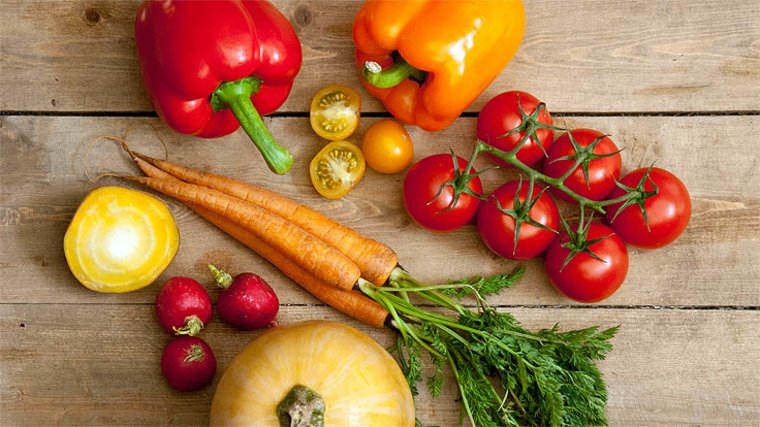
Most berries, such as raspberries and blackberries, as well as kiwis, celery, cruciferous vegetables, lemons, and many leafy greens like kale, have an alkaline pH. These colorful fruits and vegetables are considered alkaline foods that help counteract the acidity in your body.
 Tips for Eating More Fruits and Vegetables
Tips for Eating More Fruits and Vegetables
Salads don’t have to be boring with just tomatoes and cucumbers on a bed of greens. Get creative and make different salads for each night of the week. For example, try making Taco Salad for Tuesday night, a delicious mix of chopped red onions, sautéed yellow and red tomatoes, detoxifying cilantro, chopped green onions, red cabbage chunks with guacamole, and maybe even some sweet potatoes with a lime and avocado dressing.
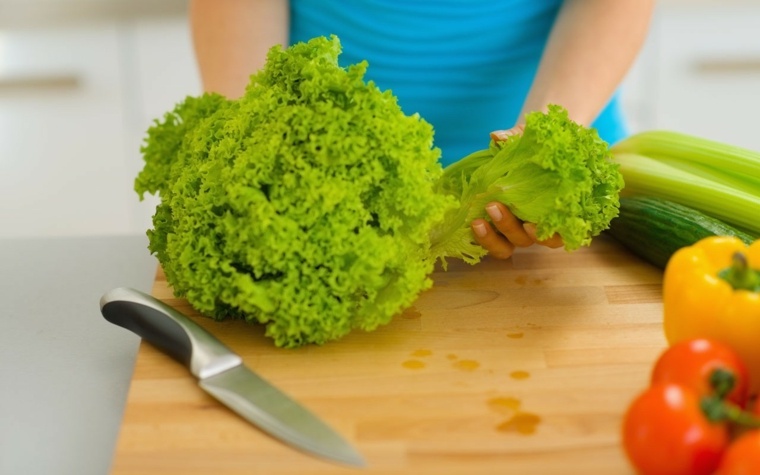
Swap artificial food coloring for natural alternatives. Use carrot and orange juice to add an orange hue to a cake. Turmeric can also be used for this purpose. Beets and red cabbage are great natural purple dyes that can be used in various recipes. Forget about artificial sweeteners and opt for homemade elderberry juice to add to your pancakes for additional nutritional benefits.
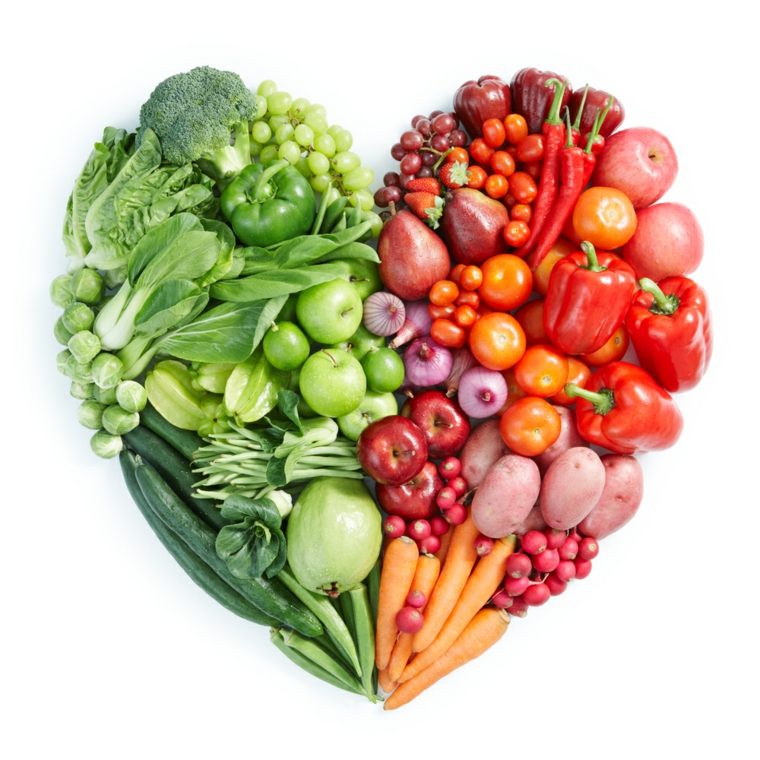 Conclusion
Conclusion
Fruits and vegetables are crucial components of a healthy diet. Consuming them daily in sufficient quantities can help prevent cardiovascular diseases and certain types of cancer. The World Health Organization recommends eating a minimum of 400g of fruits and vegetables per day to prevent chronic diseases such as cancer, diabetes, and obesity. By combining different colors of fruits and vegetables, we can obtain all the health benefits they provide.

